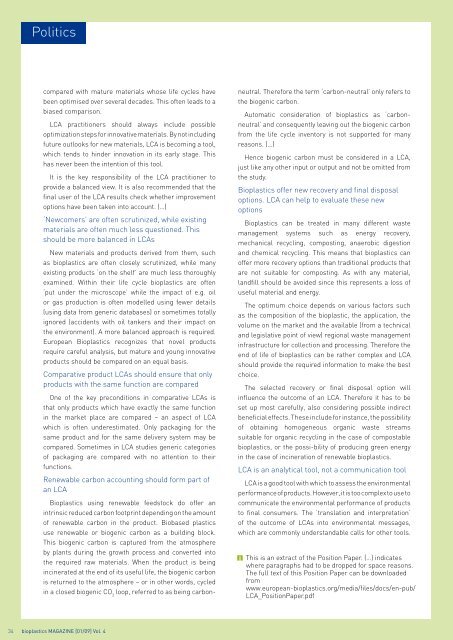bioplasticsMAGAZINE_0901
bioplasticsMAGAZINE_0901
bioplasticsMAGAZINE_0901
You also want an ePaper? Increase the reach of your titles
YUMPU automatically turns print PDFs into web optimized ePapers that Google loves.
Politics<br />
compared with mature materials whose life cycles have<br />
been optimised over several decades. This often leads to a<br />
biased comparison.<br />
LCA practitioners should always include possible<br />
optimization steps for innovative materials. By not including<br />
future outlooks for new materials, LCA is becoming a tool,<br />
which tends to hinder innovation in its early stage. This<br />
has never been the intention of this tool.<br />
It is the key responsibility of the LCA practitioner to<br />
provide a balanced view. It is also recommended that the<br />
final user of the LCA results check whether improvement<br />
options have been taken into account. (…)<br />
‘Newcomers’ are often scrutinized, while existing<br />
materials are often much less questioned. This<br />
should be more balanced in LCAs<br />
New materials and products derived from them, such<br />
as bioplastics are often closely scrutinized, while many<br />
existing products ‘on the shelf’ are much less thoroughly<br />
examined. Within their life cycle bioplastics are often<br />
‘put under the microscope’ while the impact of e.g. oil<br />
or gas production is often modelled using fewer details<br />
(using data from generic databases) or sometimes totally<br />
ignored (accidents with oil tankers and their impact on<br />
the environment). A more balanced approach is required.<br />
European Bioplastics recognizes that novel products<br />
require careful analysis, but mature and young innovative<br />
products should be compared on an equal basis.<br />
Comparative product LCAs should ensure that only<br />
products with the same function are compared<br />
One of the key preconditions in comparative LCAs is<br />
that only products which have exactly the same function<br />
in the market place are compared – an aspect of LCA<br />
which is often underestimated. Only packaging for the<br />
same product and for the same delivery system may be<br />
compared. Sometimes in LCA studies generic categories<br />
of packaging are compared with no attention to their<br />
functions.<br />
Renewable carbon accounting should form part of<br />
an LCA<br />
Bioplastics using renewable feedstock do offer an<br />
intrinsic reduced carbon footprint depending on the amount<br />
of renewable carbon in the product. Biobased plastics<br />
use renewable or biogenic carbon as a building block.<br />
This biogenic carbon is captured from the atmosphere<br />
by plants during the growth process and converted into<br />
the required raw materials. When the product is being<br />
incinerated at the end of its useful life, the biogenic carbon<br />
is returned to the atmosphere – or in other words, cycled<br />
in a closed biogenic CO 2<br />
loop, referred to as being carbonneutral.<br />
Therefore the term ‘carbon-neutral’ only refers to<br />
the biogenic carbon.<br />
Automatic consideration of bioplastics as ‘carbonneutral’<br />
and consequently leaving out the biogenic carbon<br />
from the life cycle inventory is not supported for many<br />
reasons. (…)<br />
Hence biogenic carbon must be considered in a LCA,<br />
just like any other input or output and not be omitted from<br />
the study.<br />
Bioplastics offer new recovery and final disposal<br />
options. LCA can help to evaluate these new<br />
options<br />
Bioplastics can be treated in many different waste<br />
management systems such as energy recovery,<br />
mechanical recycling, composting, anaerobic digestion<br />
and chemical recycling. This means that bioplastics can<br />
offer more recovery options than traditional products that<br />
are not suitable for composting. As with any material,<br />
landfill should be avoided since this represents a loss of<br />
useful material and energy.<br />
The optimum choice depends on various factors such<br />
as the composition of the bioplastic, the application, the<br />
volume on the market and the available (from a technical<br />
and legislative point of view) regional waste management<br />
infrastructure for collection and processing. Therefore the<br />
end of life of bioplastics can be rather complex and LCA<br />
should provide the required information to make the best<br />
choice.<br />
The selected recovery or final disposal option will<br />
influence the outcome of an LCA. Therefore it has to be<br />
set up most carefully, also considering possible indirect<br />
beneficial effects. These include for instance, the possibility<br />
of obtaining homogeneous organic waste streams<br />
suitable for organic recycling in the case of compostable<br />
bioplastics, or the possi-bility of producing green energy<br />
in the case of incineration of renewable bioplastics.<br />
LCA is an analytical tool, not a communication tool<br />
LCA is a good tool with which to assess the environmental<br />
performance of products. However, it is too complex to use to<br />
communicate the environmental performance of products<br />
to final consumers. The ‘translation and interpretation’<br />
of the outcome of LCAs into environmental messages,<br />
which are commonly understandable calls for other tools.<br />
This is an extract of the Position Paper. (…) indicates<br />
where paragraphs had to be dropped for space reasons.<br />
The full text of this Position Paper can be downloaded<br />
from<br />
www.european-bioplastics.org/media/files/docs/en-pub/<br />
LCA_PositionPaper.pdf<br />
34 bioplastics MAGAZINE [01/09] Vol. 4


















